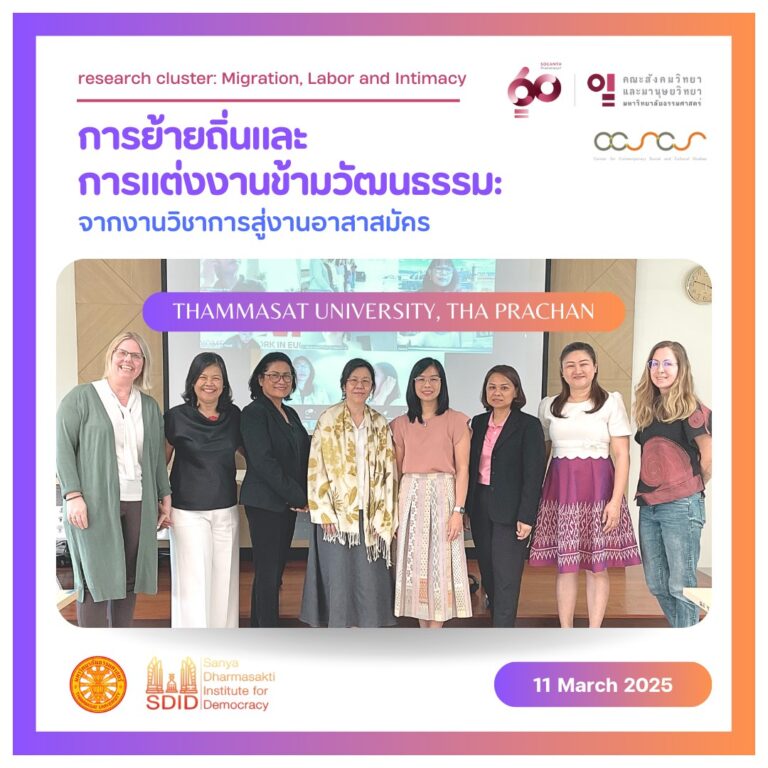Homecoming: Thai Youth Cultural Program
Bangkok and Lopburi provinces 21-25 July 2014
Evaluation Report no. 2 for the Thai Women Network in Europe (TWNE)
Summary of the report
Asuncion Fresnoza-Flot, Ph.D. Evaluator
30 August 2014
This report presents the results of an evaluation conducted on 21-25 July 2014 for the Thai Women Network in Europe (TWNE). The event that had been evaluated is the Homecoming: Thai Youth Cultural Program organized by the Thai Ministry of Culture. The evaluation was conducted to assess the program, to identify its strengths and weaknesses and to specify areas to be improved in order to ensure the success of future Homecoming programs.
Political leaders, NGOs and Thai migrants will find this report useful. One of the major findings of the evaluation points to the importance of children’s perspective and initiative to participate in the program. Some young participants joined the program only to follow their parents’ will and not their own choice, which affected the way they got involved themselves in the program activities.
Another important finding is the necessity of taking into account children’s socio-demographic profile in designing the program. Except one, all the children participants resided in other countries mostly in Europe and some experienced tiredness due to jet lag, which reduced their mental and physical capacity crucial to activity participation.
Moreover, not all these children understand and speak well the Thai language as well as eat Thai foods. It is therefore recommended for future organizers of the Homecoming program to consider during activity planning these factors and understand better their young participants. The opinions and suggestions of participants’ parents can also serve as additional information to improve the program.
Background of the program
The origin of the Homecoming program can be traced back in 2010 when the Thai Ministry of Foreign Affairs and the Thai Ministry of Culture with the collaboration of Thai Women Network in Europe (TWNE) organized this event for the first time. The program aims to introduce Thai culture to children with Thai origin residing abroad and to impart knowledge on them about Thai history and society.
This target group composes the offspring of Thai nationals who are in couple either with their co-nationals or with foreign men or women in other countries or in Thailand. Thirty children participated in the Homecoming program in 2010, whereas only ten in 2011. The Homecoming program was interrupted during two years (2012-2013), and it was re-launched only this July 2014.
This time, the Thai Ministry of Culture in collaboration with the Thai embassy in Europe and the TWNE organized and supervised the program. Seventeen children and youth aged 7 to 18 from seven countries (Belgium, Germany, Japan, Luxembourg, Switzerland, Thailand and USA) participated in the program. Three mothers of participants and three observers (including the evaluator) also took part in the program. The Homecoming event took place in Bangkok and in Lopburi province.
In Bangkok, the activities conducted during two days include the following: opening ceremony, orientation and introduction of the program, Thai social etiquette session, traditional dance and martial arts class, and visits to places such as Grand Palace, Emerald temple, Siam Museum and Siam Niramit.
The last three days of the program were spent in Lopburi province visiting the following places: historical park in Ayutthaya, Khao Wongkot temple, Bansai museum, Thai Beng Tribe village, Narai Rachaniwet and Prang Sam Yot. Other activities included river sightseeing, bat watching, handicraft sessions, and group presentations.
Throughout the program, participants were able to taste different varieties of Thai foods during breakfast, lunch, dinners and snacks. The organizers distributed the program of activities and name tags for the participants during the first day of the event. The former served as daily guide to participants, whereas the latter helped the program staff to easily identify participants.
Below is the list of the program staff:
Ministry of Culture
Thai Women Network in Europe
Phiranai Chotikanta (director of cultural network)
Chukeephorn Gysin-Preechatheeraasart (coordinator)
Kannika Sinprasert (coordinator)
Tanatchai Manketwit (coordinator)
Chatabut Neelarattanon (coordinator)
Vittayapol Rattanakul (coordinator)
At the end, staff distributed questionnaire to the participants to get their feedback about the program.
Evaluation description
This evaluation report assesses the effectiveness of the Homecoming program and had been carried out under the request of the TWNE. The evaluation had been conducted during the program through the use of the following data-gathering methods: participant observation, survey, informal conversations and photography. These methods generated three forms of data sets: observation notes, survey results and photographs. In order to ensure accuracy, the evaluator consulted materials distributed during the program and talked with some program staff and some participants.
Evaluation results
The following presents the major observations of the evaluator, which identify areas to be improved for the next Homecoming program. Most of these information came from the survey conducted by the evaluator among the youth participants of the program, and have been supplemented by her other data gathered.
Profile of the participants
The seventeen participants were all students and mostly residing in Europe. Among them, four were aged between 7 and 10 and the rest between 11 and 18. There were more female than male participants: 12 versus 5. Three mothers joined the program to be with their children: two aged 7 and 9 respectively, and the two others who were siblings were 14 and 12 years old respectively. All the participants spoke two or more languages including Thai, and their proficiency in the latter varied: many spoke very well Thai, whereas few others most often did not understand all the explanations provided by the program staff.
The table below summarizes the socio-demographic profile of the participants:
17 participants (5 boys and 12 girls)
Age groups: 7-10 years old (4 persons); 15 years old (7 persons); 16-18 years old (6 persons)
Countries where they came from: 4 from Malaysia; 4 from Switzerland; 3 from Luxembourg; 2 from Japan; 2 from Belgium; 1 from Thailand and 1 from USA
Nationalities: 12 have single nationality; 2 have double nationalities; 3 did not answer
Languages: 2 speak five languages; 2 speak four languages; 7 speak three languages; 6 speak two languages
Sources of information about the program
Most of the participants obtained information about the program from their Thai mothers and few from their Thai teachers, the Thai embassy in their respective countries, and from their friends.
Registration fee
There was no registration fee for the children delegates thanks to the Ministry of Culture. However, only the three mothers and three observer participants were asked to pay the fee amounting to 6990 Baht. This did not pose any problem, except the difficulty to get an official receipt of payment that some adult participants (including the evaluator) needed for reimbursement purpose after the program. This complication was solved with the help of the TWNE coordinator who accepted to sign the non-official “receipt” they received.
Reasons of participation
Ten participants decided by themselves to join the program, six reported to be “told to do so” and one confided to be “forced” to participate. These reasons influenced the way these participants involved themselves in the activities organized during the program.
Expectations of participants
Majority of the participants joined the program with the following expectations: “to know Thai culture”, “to find new friends”, obtain “new” or “more knowledge”, for “fun”, and “speak better Thai”.
Involvement of the participants in the program
Based on the survey and observations conducted, participants’ involvement in the program varied according to time, their reason of participation and types of activity. According to time, participants showed a lot of enthusiasm at the beginning of the program, then during the middle most of them looked tired and less responsive, and finally enthusiasm increased again at the end of the program.
In terms of reason of participation, those who were “told to do so” or “forced” by their Thai mothers to join the program showed less eagerness to participate. For example, one male participant who confided to be “forced” by her mother always distanced himself from the group, kept silent most often, slept on the table during a meal, and refused sometimes to try Thai foods.
Finally, it is observable how the type of activity offered to participants influenced their interest to get involved. For example, activities such as Thai dance and Muay Thai sessions, handicraft courses, and river cruising appear to attract more interests from the participants than visit in museums or parks.
It is interesting to note that the age of the participants did not determine their degree of involvement in the program. Two participants aged 7 and 9 respectively actively participated in many activities, and showed a lot of interest to be with the group. One even cried at the end of the program thinking about his new found friends. The enthusiasm of these very young participants can be explained by the presence of their mothers during the program and their better level of Thai compared to some grown-up participants.
Accommodation
Homecoming program participants and staffs stayed in SD Avenue Hotel in Bangkok and in Ruen Rub Tawan and Bann Suan Malithong resorts in Lopburi. The first hotel appeared to be very convenient for the participants and their families. Some close relatives could even easily visit them in the hotel. The only thing that seemed inconvenient notably for parents and observers who joined the program was internet connection, as you need to pay and to be in the lobby to be able to connect. In Lopburi, this internet inconvenience was not a problem at all in the two resorts where participants stayed.
However, during one-night of stay in the first resort, some participants were not able to sleep well due to the following reasons: it was “hot” in the room despite the air-conditioning and “noises” made by other participants. Overall, what appears to be the most convenient accommodation for the youth participants is hotel than resort.
Transportation
The air-conditioned bus was a very useful and comfortable means of transportation throughout the Homecoming program. You could see how participants appreciated a lot to go inside the bus each time after a long promenade under a big sun. There was enough space in the bus and the air-conditioning was not too cold.
Foods
There was variety of Thai foods, but not all of the youth participants took advantage of this opportunity to taste these foods. One could observe that a few participants preferred to eat non-Thai foods such as French fries or none at all. The behavior of these participants reflect what foods they eat at home: they mostly consume non-Thai foods. On the contrary, participants who showed a lot of appetite in eating Thai foods were the ones whose Thai parents prepare most of the time Thai foods at their home.
Activities
The activities during the program were all well prepared, but not all of them had captured the enthusiasm of the participants. Some appeared to be “boring” for a few participants, notably visit in museums and parks. What seemed to be more interesting for the participants were activities that involved physical movements and personal investment such as Thai dance class, Muay Thai session and handicraft courses. Activities with a bit of adventure like river cruising was also appealing for the participants.
Overall organization of the program
The Ministry of Culture, the Thai Embassy in Europe and the TWNE did a very good job in organizing the Homecoming program. Activities were diverse and took place on time. Nevertheless, its intensity and timing often exhausted all the energy of young participants. Finishing late at night did not give much time for them to sleep and regain their lost energy. It must also be noted that a few participants still suffered from jet lag, and this made it particularly challenging for them to be always mentally present throughout the program. For instance, one teen-age participant could not help to sleep at some points during the program.
Interest in the next Homecoming program
Among the participants, eleven expressed their intention to participate again in the next Homecoming program. Those who will be passing the age requirement of 7 to 18 years old knew that they could not participate anymore even if they would like to.
Discussion of the results
The evaluation results above suggest that there are strengths and weaknesses of the Homecoming program. Its strengths include its well-organized activities, the amenities it offered to participants such as air-conditioned bus rides and comfortable accommodations, the variety of Thai foods prepared, and the interesting historical places where it brought the participants.
In terms of weaknesses, there were only two: not enough time given for the participants to sleep longer due to intensive activities and insufficient language assistance for some participants who were not well-versed in the Thai language. What is obvious is that there are factors that could have contributed to these evaluation results. First, the personality of the young participants and their proficiency in the Thai language could have influenced the way they got involved in the program. And second, the way their Thai parent (mother of father) raise and treat them at home also had an impact: children who were exposed to Thai culture, foods and language since when they were very young were usually the ones who actively participated in the program activities.
Conclusion and recommendations
The evaluation results overall show that the Homecoming program conducted in Bangkok and Lopburi province last July 2014 was a success. Despite its weaknesses, the program was able to attain its major objective of providing useful information about Thai culture, history and society among its young participants with Thai origin. In order to ensure its success in the future, the following are some recommendations:
1) Dissemination of information about the program – There should be additional ways to disseminate information about the program. Thai associations and Thai Buddhist temples in each receiving country of Thai migrants should be contacted for such a purpose for supplemental assistance. Announcements posted in the web, facebook accounts and in some blogs of Thai migrants appear to be another effective means of information dissemination.
2) Program participation – Children should not be neither forced nor obligated by their parents to join the program. A consent form filled up by the parents must be accompanied with another consent form completed by their child(ren) expressing their own intention to participate in the program. These two forms must be submitted to the person(s)-in-charge of the next Homecoming program. This person will be the one to evaluate and choose the final participants to the program.
3) Parental participation in the program – It is advisable that younger children aged 10 and below should be accompanied by one or both of their parents throughout the program. The presence of parents gives more emotional support and guidance to very young children participants.
4) Thai language assistance – Reading materials in Thai to be distributed to program participants must have at least English translation. Participants must always be asked if they understand or not explanations given in Thai. If they do not understand everything, someone should always be available to provide them the explanations in English or in other language. Parental presence in the program can also be very useful in this case.
5) Ample time for resting and sleeping for the participants – The quantity of activities organized for the program is not important if participants lose their interest due to lack of sleep or tiredness. Dinner should be scheduled at the latest at seven o’clock in the evening, so at 8 or 8:30PM participants as well as program staff could have a bit of time for themselves, for relaxing and sleeping.
6) Future activities that will stir up participants’ interests – Activities involving physical and mental involvement must be encouraged. The following are some suggestions. – documentary film and theater plays (like the one in Siam Niramit) about Thailand; – Thai dance, Muay Thai, handicraft, Thai traditional clothes wearing and Thai cooking sessions; – immersion in Thai schools and meeting Thai students to give program participants some ideas how it will be to study in Thailand; – group survival activity: for example, participants are divided into groups, they will be asked to go with one or two program staff to a particular place (market, mall or park) to find a particular item/object, communicating in Thai with the locals will be the main objective of this activity); – one-hour Thai language course every day during the program to learn some basic Thai words and expressions; – cultural games: for example, organization of a multiple choice quiz competition about Thailand, participants are divided into groups and each group will be competing with one another to find the right answer. Such an activity is ideal after lunch or early dinner; and – trip and picnic in a beach: Thailand is known for its beautiful beaches and sea, and young people are interested in outdoor activities particularly if it will be near the sea.
7) Future program assessments – At the end of each day during the program, delegates should be requested to anonymously write in a piece of paper what they think and feel about the activities they did during the day. This will give ideas to program staff what to improve on the next day. In addition, an independent evaluator who is not affiliated to the organizing institutions should be invited to join the program as observer. Feedback from this evaluator will be valuable for the future Homecoming programs.
————
Information about the evaluator
Asuncion Fresnoza-Flot is a postdoctoral research fellow of the Belgian National Fund for Scientific Research (FNRS) at the Interdisciplinary Research Center on Families and Sexualities (CIRFASE) at the Catholic University of Louvain in Belgium. She is also a research associate at the ‘Migrations and Society’ Research Unit (URMIS) at University Paris Diderot – Paris 7 in France, where she completed her Master’s degree in ‘Migration and interethnic relations’ in 2005 and her PhD in Sociology in 2008. Since 2009, she is taking part in a collaborative research funded by the Japan Society for the Promotion of Science (JSPS) on children of Filipino migrants in selected countries including France. Her other ongoing research focuses on children of Filipino-Belgian and Thai-Belgian families in Belgium.
Contact details: Bureau a.343, CIRFASE Catholic University of Louvain Place Montesquieu 1, bte L2.08.01 1348 Louvain-la-Neuve, Belgium Tel. + 32 0(10) 47 42 12 Email: asuncion.fresnoza@uclouvain.be




